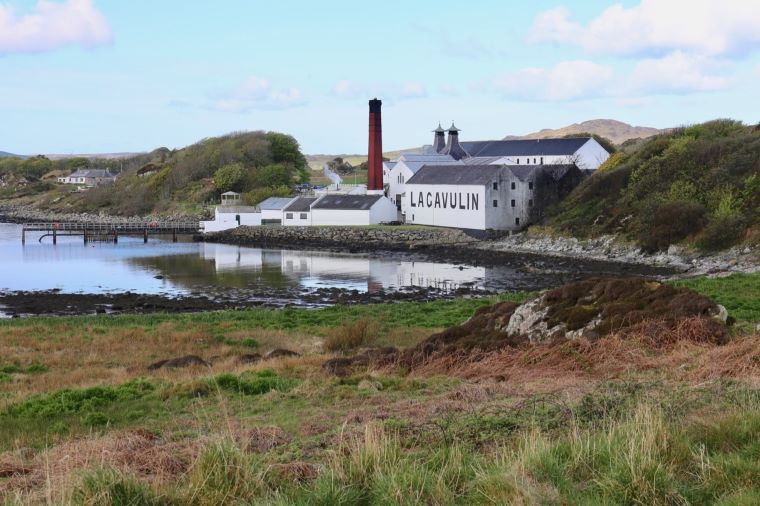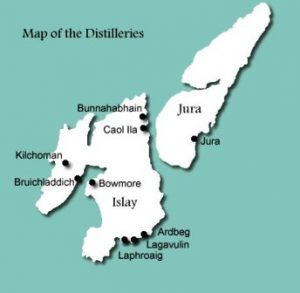
The history of whisky making on Islay is believed to have been started by Celtic monks traveling from Ireland. They stopped off on their way through the Hebrides and by the time the Customs & Excise Act was passed in 1823, there were estimated to be over 200 illicit stills hidden in various locations across the island. Now there are eight legal distilleries producing single malt whisky on Islay.
Ardbeg sits on the south eastern shore and the distillery was officially founded in 1815 by John MacDougall. However records show that a distillery was operating on the Ardbeg site as early as 1794. It has an annual production capacity of one million litres and is currently owned by Moet Hennessey (LVMH). They took over (indirectly via Glenmorangie plc) in 1997 following periods of closure by previous owners and have grown Ardbeg in to the cult classic that it is today. It offers some of the smokiest whiskies available and is one of the most active and innovative brands PR-wise.
Bowmore is the oldest distillery on Islay and one of the oldest in all of Scotland, having been founded in 1779 by John Simpson. It is located in the village of the same name on the east shore of Loch Indaal. Bowmore is owned by Morrison Bowmore, who have been in control since 1963. They are a subsidiary of the larger Suntory drinks company from Japan, who acquired Morrison Bowmore in 1989. The annual production of the distillery is two million litres. The core range is extensive and expands across local and travel retail markets – this helps to make Bowmore one of the biggest selling single malts in the smoky/peaty style.
 Bruichladdich (pronounced brook-lad-ee) is located on the western shore of Loch Indaal. The distillery was originally founded in 1881 by Barnett Harvey – it was built using stones from the local beach and was one of the first buildings in the UK to be constructed using concrete. Remy-Cointreau are currently in control and they took control from the previous independent owners in 2012. It has an annual production capacity of one million litres and the name translates from Gaelic as ‘the brae (hillside) by the shore’. Their range is extensive and they are well known for their innovative and experimental use of casks.
Bruichladdich (pronounced brook-lad-ee) is located on the western shore of Loch Indaal. The distillery was originally founded in 1881 by Barnett Harvey – it was built using stones from the local beach and was one of the first buildings in the UK to be constructed using concrete. Remy-Cointreau are currently in control and they took control from the previous independent owners in 2012. It has an annual production capacity of one million litres and the name translates from Gaelic as ‘the brae (hillside) by the shore’. Their range is extensive and they are well known for their innovative and experimental use of casks.
Bunnahabhain (pronounced boo-na-ha-van) is located in the northern eastern coast of Islay. The distillery is seen as something of a ‘black sheep’ as it has non peated whiskies at the core of their range. Bunnahabhain was founded in 1881 by William Robertson and has endured a turbulent history with a number of closures and part closures. The most recent was between 1999 and 2002 when it was closed for the summer months due to poor availability at its local water source. The distillery is owned by Burn Stewart and produces 2.5 million litres per year, much of which goes towards their popular Black Bottle blend.
Caol Ila (pronounced cull-ee-la) was founded in 1846 by Hector Henderson and is located on the remote northeast coast of the island, close to Bunnahabhain. The name means ‘Sound of Islay’ in Gaelic and it is surrounded by cliffs and caves on three sides. The sound of Islay is the narrow stretch of water that separates Islay from the neighbouring island of Jura and the distillery overlooks this. Caol Ila is owned by Diageo and the single malt is a key ingredient in many of their blends, including Johnnie Walker. It is the largest distillery on Islay and has an annual capacity of around six million litres.
Kilchoman (pronounced kil-ho-man) is the baby of the group. It is independently owned and was founded by the Kilchoman Distillery Group in 2005. This makes it one of the youngest distilleries in Scotland. It is also one of the smallest – its annual production capacity is just 100,000 litres. Kilchoman is located on the western side of Islay and is named after the local church parish. The first single malt was released in 2009 and since then the distillery has gained a cult following, along with numerous awards and plaudits.
Lagavulin (pronounced lagga-voo-lin) was founded in 1816 by John Johnston and is located in the hamlet of the same name on the south eastern coast of Islay. It overlooks the compact Lagavulin Bay and is dominated by the ruins of Dunyvaig Castle, which dates back to the 13th century. It is currently owned by Diageo and has an annual capacity of 2.5 million litres. The name translates as ‘mill by the bay’ from the local Gaelic dialect. The 16 years old expression is widely regarded as one of the best examples of the smoky peaty style and forms part of Diageo’s Classic Malts series.
 Laphroaig (pronounced la-froyg) is located on the southern coast of the island. The name of the distillery is derived from the Gaelic for ‘beautiful hollow by the broad bay’. The distillery was founded in 1810 by two brothers, Alexander and Donald Johnson, and is currently owned by Beam Global. It has an annual production capacity of 3.2 million litres, making it the second largest distillery on the Island, and the 10 years old expression is the best selling smoky whisky in the world. Laphroiag is also one of the few distilleries to carry a Royal Warrant – this was awarded by Prince Charles on a visit in 1994 as Laphroaig is one of his favourite whiskies.
Laphroaig (pronounced la-froyg) is located on the southern coast of the island. The name of the distillery is derived from the Gaelic for ‘beautiful hollow by the broad bay’. The distillery was founded in 1810 by two brothers, Alexander and Donald Johnson, and is currently owned by Beam Global. It has an annual production capacity of 3.2 million litres, making it the second largest distillery on the Island, and the 10 years old expression is the best selling smoky whisky in the world. Laphroiag is also one of the few distilleries to carry a Royal Warrant – this was awarded by Prince Charles on a visit in 1994 as Laphroaig is one of his favourite whiskies.
The Port Ellen Maltings is the other major facility on Islay related to the whisky industry. This is located just outside of the village of Port Ellen and was built in 1973 by DLC (which is now Diageo). It is located next to the site of the old Port Ellen distillery, which was closed in 1983 and has since been demolished. The warehouses remain and these back on to the sea. The Maltings produce and provide most of the malted barley for Islay’s distilleries. It is the only malting facility on the west coast of the UK and the only one in the UK that uses peat to dry the barley.
Listen to the article here;




















Leave a Comment